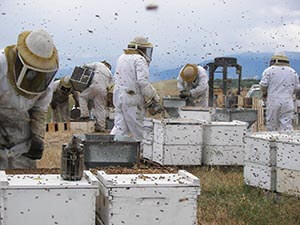
Uncertainty over the supply of packages and queens to Canada should make us re-evaluate the sustainability of our practices
If any industry should be sheltered from the shock of COVID-19, it should be beekeeping. After all, beekeepers have been socially distancing since the day we picked up our hive tools. But on March 23, I got a call saying that my queen order, scheduled for arrival in late April, had been cancelled. Suddenly, beekeeping started looking a lot less sheltered.
For me, a cancelled queen order is not a big deal — it just meant that I couldn’t do the experiments I had planned. But for a beekeeper with skin in the game, a cancelled or delayed order could be a substantial setback to their bottom line.
Canadian beekeepers rely heavily on imported packages and queens early in the season, before domestic production begins. In British Columbia, the province with the mildest winters, the first round of packages arrived in the middle of March from Tasmania, Australia, before the global distribution chain had been broken.
But other provinces have longer winters, and packages don’t usually arrive until later in the spring, when most flights were already grounded. And as the season advanced, demand for queens increased for making early splits before local queens were ready. This year, that demand fell on uncertain circumstances.
“You quickly realize how complex the economy is,” says Martin Regan, co-owner of Aussie Bees Canada. In Australia, laborers now have to quarantine for 14 days when moving between states. And since most workers are not locals, it has been hard for queen and package businesses to stay operating, let alone transport their product overseas.
“Queens should be able to come at the end of the month [April], but things can change so fast.” Regan says they’re working on getting an Air Canada cargo flight from Australia to Vancouver, Canada, but it depends on if it’s commercially viable for the airline and if there is a governmental or public need to transport other supplies.
Regan estimates that only 40% of Australian packages will arrive in Canada compared to last year. It’s a big drop, but Australia’s packages are a small fraction of Canada’s imports: Others come from Chile, but the overwhelming majority of Canada’s annual ~40,000 package imports come from New Zealand. Producers there are still operating, but they can’t get their packages off the ground.
“We did get queens on a flight last Tuesday [April 14],” says Chris Bartel, co-owner of Bartel Honey Farms, who imports around 16,000 New Zealand packages every year. “We didn’t have time to put packages on it. It’s a good thing, because the departure time delayed three times and was rerouted to pick up passengers.” It would have been the death of the bees, he says, and he’s getting “less and less hopeful” about the prospect of future flights.
Bartel managed to import some packages in March, but only about 20% of their New Zealand package orders have been filled so far, and other importers are in similar situations. This is bad news for Ontario and Quebec beekeepers, who had larger orders this year to fill blueberry pollination contracts. Blueberries are Canada’s top fruit export, and production was expected to increase this year, since the market is recovering from the glut.
The growers don’t have many options. Some pollination contracts might still be filled using local bees. But, as Bartel points out, when beekeepers make splits to boost colony numbers for the following year, they use only one or two brood frames. If these splits are going into pollination this year, they will need to start with more brood. Beekeepers would get fewer splits out of their colonies, which could set their operations back for 2021.
The situation is grim for Canada, but American operations seem to be weathering the COVID-19 storm. Ray Olivarez, owner of Olivarez Honey Bees in California, says that, if anything, production is up over last year due to better weather.
“We’re happy to be working,” Olivarez says. “We want our employees to feel safer at work than they do at home.” They have had to hire extra workers because social distancing measures make some aspects of the operation less efficient, and they have lost some workers who needed to stay home and look after family members. But overall, queen and package demand has been steady, labor has been sufficient, and the weather has been favourable.
Key factors to Olivarez Honey Bees’ success are that they don’t rely on annual package imports from the southern hemisphere, they tend to hire local workers so they aren’t suffering from labor shortages, and their main business is domestic supply of packages and queens, rather than exports. They do supply Canada with queens, but Olivarez says that’s mainly for the sake of diversification.
At the time I spoke with Olivarez, in mid-April, they had already shipped packages as far east as Wisconsin and Ohio, and it doesn’t look like their distribution system will be disrupted. “Shipping hasn’t changed for us so far,” he says.
Kona Queens, which normally supplies Canada with tens of thousands of queens, had a temporary shipping setback. The first round of queens destined for British Columbia wasn’t shipped because they couldn’t secure a connecting flight from Edmonton to Vancouver. But they are trying a new transportation strategy of flying the queens to Seattle and driving them across the border.
“Everything looks like a go right now,” says Mike Munro, co-owner of Delta Honey Farms in B.C., “but we don’t really know until we actually get them.” Delta Honey brokers shipments from international suppliers, including Olivarez. It looks like April’s queen orders will arrive as ….


